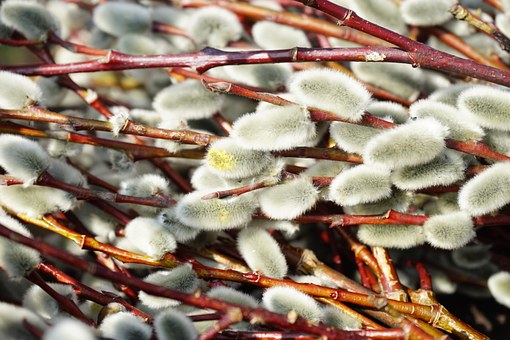|
Every morning on my way to the Bosque I keep a sharp eye out for subtle changes in the color of the Coyote Willows - Salix exigua - that line the ditches and the river. In a month or so these slender shoots and bushes will turn burnt orange or a deep rose red (depending on the soil). Here in Abiquiu they signal that spring is on the way. These flexible fronds are used by so many Indigenous peoples to make baskets, trays, etc – some even use them as thread. What I love best is their shape-shifting color especially when framed against an azure sky. Because I have two ‘home places’ I also think of another willow – Salix discolor – commonly called the native Pussy Willow. By mid February I am impatiently waiting for the first fuzzy paws to appear on the bushy branches of the pussy willows on my property. In Maine, winters are long and the advent of the pussy willow signals the coming shift of seasons long before it becomes apparent in more obvious ways, except for the warming sun. Snowfall is often heaviest during this month, and I have been known to tramp through heavy snow on snowshoes to reach some of my favorite clumps. I clip a few twigs from each bunch to put in the house. All willows are flowering plants that have abundant watery bark sap which is heavily charged with salicylic acid – the precursor of aspirin - soft, usually pliant, tough wood, slender branches, and large, fibrous roots with an astonishing ability to anchor themselves securely to the ground even when water is rushing by. The roots are remarkable for their toughness, size, and willows readily sprout from the aerial parts of the plant.
Few folks know that willows (true for other members of this family too – cottonwoods, aspen, poplar) absorb poisons like lead and other toxins cleansing the earth and water of pollutants wherever they happen to grow. In my opinion, we should all take a few moments to give thanks for having such ‘giving trees’. In Maine, some of my poplars are diseased, and I have often wondered if this is a result of their penchant for removing toxins from the ground and also may contribute to these trees’ and plants having a short life – span (at least above ground). Willows are among the earliest woody plants to leaf out in spring and the last to drop their leaves in autumn. Leaf out may occur as early as February depending on the climate and is stimulated by air temperature. If daytime highs reach 55 °F for a few consecutive days, most willows will attempt to put out leaves and flowers. Here in Abiquiu, coyote willows turn red, orange, yellow, brown, and even purple because the plants produce pigments that protect the photosynthetic pathways from being damaged by too intense light. Leaf drop in autumn occurs when day length shortens to approximately ten and a half hours. This dropping of leaves varies by latitude occurring as early as the first week of October for boreal species and as late as the third week of December for willows growing in far southern areas. This January while visiting the Bosque Del Apache to be with the Sandhill cranes for the second time this year I discovered clumps of willows that had not dropped their leaves at all. The buds form along the branch and are usually covered by a single scale that acts like a cap. This is especially obvious on pussy willow branches. Most leaves of willows are slender and feathery – quite delicate and graceful. The colors of the leaves vary depending upon the type. The flowers possess both and female catkins on separate clumps and often they appear before the leaves. The pussy willow paw is a catkin in the making. Willows are often planted on the borders of streams if they aren’t already there, so their interlacing roots may protect the bank against flooding water. Frequently, like the coyote willow, the roots are much larger than the stem that grows from them. Just try to uproot one and you will be in for a surprise! Willows are important in other ways. For some native pollinators, willows offer the first, important source of pollen and nectar (this is definitely true for pussy willows). Look closely at the male catkins that follow the buds and you will see a roil of small wasps, ants and bees and varieties of flies all crawling, burrowing around while foraging the flowers for nectar and pollen. Some list willows as second only to oaks in value as host trees for butterflies and moths like the mourning cloak, sphinx and viceroy. Leafrollers, sawflies, borers, midges and gall gnats produce an ornamental aberration called a pine-cone gall, easily visible on twig tips when willows shed their leaves. All of these represent long-evolved plant-insect associations, not to be confused with infestations more often caused by introduced insects. Willows comprise North America’s largest genus of tree-like plants. There are approximately one hundred species plus a number of hybrids. Most willows are short-lived. Willows have a wide natural distribution from the tropics to the arctic zones and are extensively cultivated around the world. In Maine an old field speckled with budding pussy willows is like a constellation come to earth, descended from the heavens and hovering just above the ground. In Abiquiu the advent of spring bursts with the glorious burnished golden sheen of the coyote willow!
0 Comments
Your comment will be posted after it is approved.
Leave a Reply. |
Submit your ideas for local feature articles
Profiles Gardening Recipes Observations Birding Essays Hiking AuthorsYou! Archives
October 2025
Categories
All
|

 RSS Feed
RSS Feed